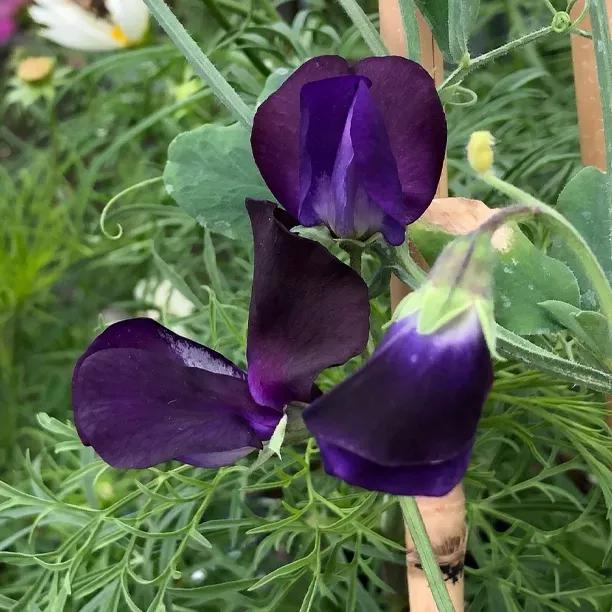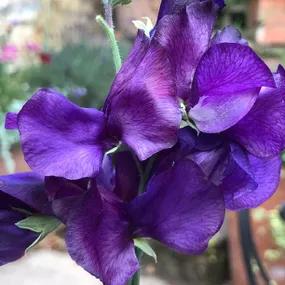Blue Velvet Sweet Peas
The details
- Colour: Intense deep blue
- Stem: Long
- Height: 2m
- Type: Spencer
- Scent: Good scent
- Flowering: May-October
- Planting Months: March-June
Recommended extras
Description
Blue Velvet Spencer Sweet Peas
Blue Velvet sweet peas (Lathyrus odoratus Blue Velvet) are the go-to variety if you're looking for a reliable deep blue Spencer-type on which to base your annual summer climbing display.
Check out our full range of sweet peas.
Our Sweet Peas are delivered in purpose-designed, recycled cardboard packaging, and are ready to be planted out when you get them.
We generally send them out between March and May, but we will email you with the likely delivery timescale once you have placed your order.
The flowers of Blue Velvet are very deep blue and when they catch the light, they often reflect different shades of violet and purple. Of course, it's all in the name - the blooms have a distinct velvet sheen, so much, so it's hard not to touch them! They're well ruffled, typical of a Spencer type and the long stems and perfume make Blue Velvet an excellent cut flower.
Goes well with other plants
The rich, dark shades of Blue Velvet need to be seen at close quarters to appreciate the subtleties of each petal's texture, so don't hide them at the back of the border. Grow them up obelisks near the front to act as a focal point, and you'll be able to stop and smell the blooms, too.
They make a beautiful contrast to more other colours in the sweet pea range than virtually any other - think pale or bright pink, creams, whites or reds. It's this ability to look good in the company of other sweet peas which makes it such a summer asset. Of course, Blue Velvet doesn't have to be teamed just with other sweet peas - try combining it with a pale climbing rose such as Iceberg Climbing or a tropical flower, like the deep red Cardinal climber (Ipomoea x sloteri).
Sweet pea Blue Velvet is suitable for growing in large containers, but plants will need extra watering and a high potash plant food (such as tomato fertiliser) to keep flowering throughout the season. Keep deadheading faded flowers to make sure blooms keep forming - if seed pods are allowed to develop, the sweet pea's flowering mechanism will switch off. This is why it's a good idea to keep them within easy reach.
Features of Blue Velvet Spencer Sweet Peas
- Colour: A rich, intense deep blue
- Stem: Long, great for cutting
- Height: 2m
- Type: Spencer
- Scent: Good scent
- Flowering: May-October
- Planting Months: March-June
- Suitable for use as a cut flower
- Perfect as a contrast with pale varieties
Did you know...
The Spencer-type sweet peas were first bred by Silas Cole, a gardener working for ancestors of Diana, Princess of Wales' family. In 1900, one of his plants threw up a sport with much larger flowers and a wavy petal edge. This bright pink variety was named Countess Spencer and was exhibited at the National Sweet Pea Society's first show, at the Royal Aquarium in 1901.
Cultivation Instructions
Plant Blue Velvet Sweet Peas in well prepared, moist soil that ideally was enriched with organic matter the previous autumn (if you did not do it then, do it now!). Erect supports for the peas to climb up before planting. They can also be planted in pots of sufficient size - allow 6 litres per plant - and with an ideal planting medium of 50% compost, 40 %top soil and 10% well rotted manure. General purpose compost will do however but produces fewer flowers.
The principal requirement is enough water - Sweet Peas are thirsty and hungry plants. They can cope with a little shade but flower better in full sun.
Space plants about 10-15 cm apart and 5 cm from their support. The hole should be deep enough to accommodate the longest root and the soil should come up to the level of the first side shoot. Use wire/netting/twine between the supports so that the Sweet Pea can climb naturally. You will still need to tie them into the frame. They grow fast, so check every ten days or so.
Water well; the soil around sweet peas should never dry out. As the flowers develop pick them, and then pick again, otherwise they start to form seedpods and will stop flowering altogether. Keep tying in and picking for as long as you can. Perfectionists will remove the curling tendrils which grip other stems and can result in flowers with wiggly stems and also will remove side shoots. see the website for more advice on training sweetpeas.
By all means apply a high potash and phosphate fertiliser during the growing season. (Sweet Peas actually fix nitrogen from the air into the soil so you don't need more of that.) Home-made comfrey liquid is perfect or Tomorite will do especially if you are on a sandy soil.




